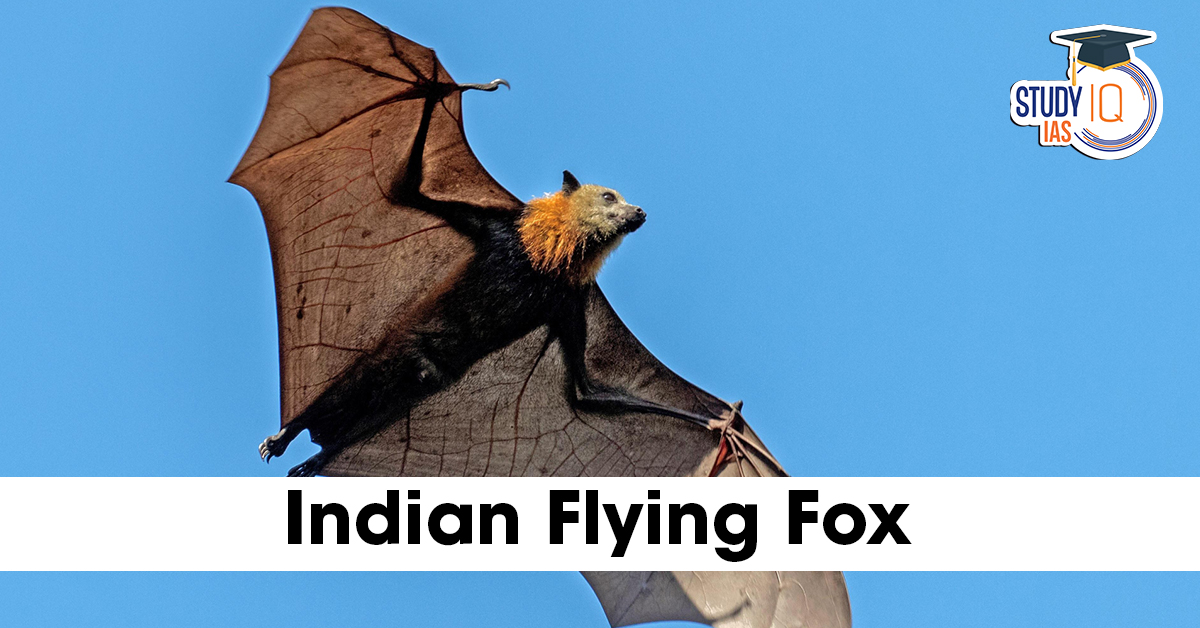Table of Contents
The Indian Flying Fox (Pteropus giganteus), a giant among bats, gained additional prominence recently when a related question regarding this extraordinary animal was removed by UPSC in its 2024 prelims examination. This fascinating mammal is of importance for upholding ecological balance and biodiversity in the Indian subcontinent.
Here in this article, we discuss everything you need to know about the Indian Flying Fox, its features, behavior, habitat, conservation status, and ecological importance.
What is the Indian Flying Fox?
Indian Flying Fox is one of the large fruit bats in South Asia that belongs to the family Pteropodidae. It is famed for its size and fox-like facial shape and is also referred to as the Greater Indian Fruit Bat. Unlike birds, it is a mammal that is able to fly, and it is one of the few mammals with this capability.
| Details | |
|---|---|
| Scientific Name | Pteropus giganteus |
| Common Names | Indian Flying Fox, Greater Indian Fruit Bat |
| Classification | Mammalia (Class), Chiroptera (Order), Pteropodidae (Family) |
| Size / Wingspan | Wingspan ranges from 1.2 to 1.5 meters |
| Appearance | Large bat with dark brown/black fur, yellowish mantle around neck, fox-like face |
| Habitat | Tropical and subtropical forests, swamps; roosts on large trees like banyan, fig, tamarind |
| Geographical Range | India, Pakistan, Bangladesh, Sri Lanka, Nepal, Bhutan, Maldives |
| Diet | Frugivorous – feeds on ripe fruits (mango, banana, guava), nectar |
| Behavior | Nocturnal; roosts in large colonies; emits ultrasonic sounds for echolocation |
| Ecological Role | Keystone species for pollination and seed dispersal; maintains ecosystem health and biodiversity |
| Conservation Status | IUCN: Least Concern (LC); Protected under Schedule II of the Wildlife Protection Act, 1972 |
| Human Conflict | Considered pests by fruit farmers, a possible Nipah virus carrier |
| Unique Feature | Only flying mammal with a large wingspan; uses echolocation for navigation |
| Recent Research | Exhibits daytime vigilance behavior during roosting to detect threats |
Indian Flying Fox: Physical Characteristics
-
Size and Wingspan:
-
Wingspan ranges from 1.2 to 1.5 meters, making it one of the largest bats globally.
-
-
Appearance:
-
Body color varies from dark brown to black.
-
Has a distinctive yellowish or orange mantle around the neck, typical of the Pteropus genus.
-
-
Unique Features:
-
Equipped with sharp claws on wings and legs.
-
Cannot perch like birds; instead, hangs upside down from tree branches using claws.
-
Indian Flying Fox: Behavior and Habitat
-
Activity Pattern:
-
Nocturnal and arboreal species. Active at night and roosts during the day.
-
-
Roosting Colonies:
-
Forms large colonies on tall trees such as banyan, fig, and tamarind. Colonies can number in the thousands.
-
-
Daytime Vigilance:
-
Recent research shows they spend about 7% of their daytime resting, being vigilant against predators or threats.
-
-
Social Structure:
-
Highly social, live in densely packed colonies, facilitating social interactions.
-
-
Roosting Environment:
-
Prefer areas near water bodies, tropical forests, swamps, and even urban parks.
-
Indian Flying Fox: Ecological Importance
-
Diet:
-
Mainly feed on ripe fruits (mango, guava, bananas) and nectar from flowers.
-
-
Pollination and Seed Dispersal:
-
Play a critical role as pollinators and seed dispersers, aiding forest regeneration and biodiversity.
-
-
Keystone Species:
-
Considered a keystone species due to their outsized impact on ecosystem health.
-
-
Navigation:
-
Primarily rely on sight and smell, but also use ultrasonic sound emissions for navigation and communication.
-
Indian Flying Fox: Conservation Status
-
IUCN Status:
-
Listed as Least Concern (LC) by the IUCN.
-
-
Legal Protection:
-
Protected under Schedule II of the Wildlife (Protection) Act, 1972.
-
Listed in Appendix II of CITES.
-
-
Threats:
-
Habitat loss due to deforestation and urbanization.
-
Hunting and persecution, especially due to crop damage.
-
-
Human-Wildlife Conflict:
-
Considered pests by fruit farmers.
-
Possible vectors of zoonotic diseases like the Nipah virus.
-
Challenges and Conservation Efforts
-
Balancing Conservation & Agriculture:
-
Awareness campaigns aim to educate farmers about the ecological benefits of Indian Flying Foxes.
-
Development of conflict mitigation strategies to reduce crop damage without harming bats.
-
-
Habitat Protection:
-
Protecting natural roosting sites and maintaining forest corridors is essential.
-
-
Research and Monitoring:
-
Continuous scientific research to understand behavior, disease transmission risks, and ecological impact.
-
Indian Flying Fox UPSC
Indian Flying Fox is a wonderful creature that plays a great role in fulfilling ecological balance through pollination as well as seed dispersal. Despite the odds of human-wildlife conflict and habitat stress, conservation initiatives even now emphasize their importance. For UPSC aspirants as well as nature lovers, it becomes important to learn about the Indian Flying Fox to understand and know the marvelous biodiversity of India and the intricate network of associations in ecosystems.


 World Summit on Disaster Management (WSD...
World Summit on Disaster Management (WSD...
 Domestic Systemically Important Banks (D...
Domestic Systemically Important Banks (D...
 The Missing Link in India’s Critical M...
The Missing Link in India’s Critical M...

























